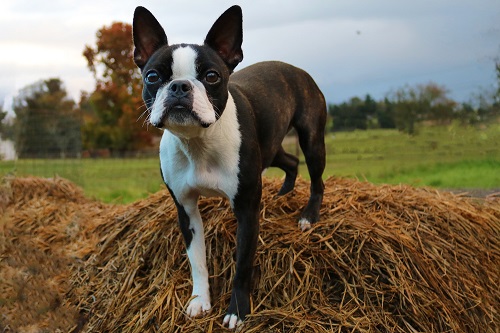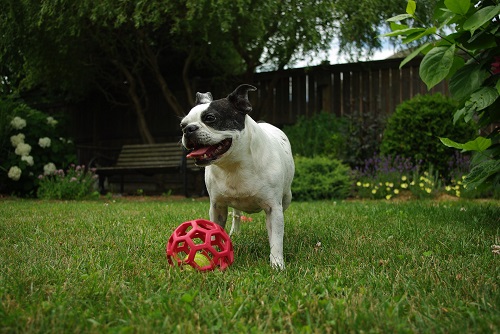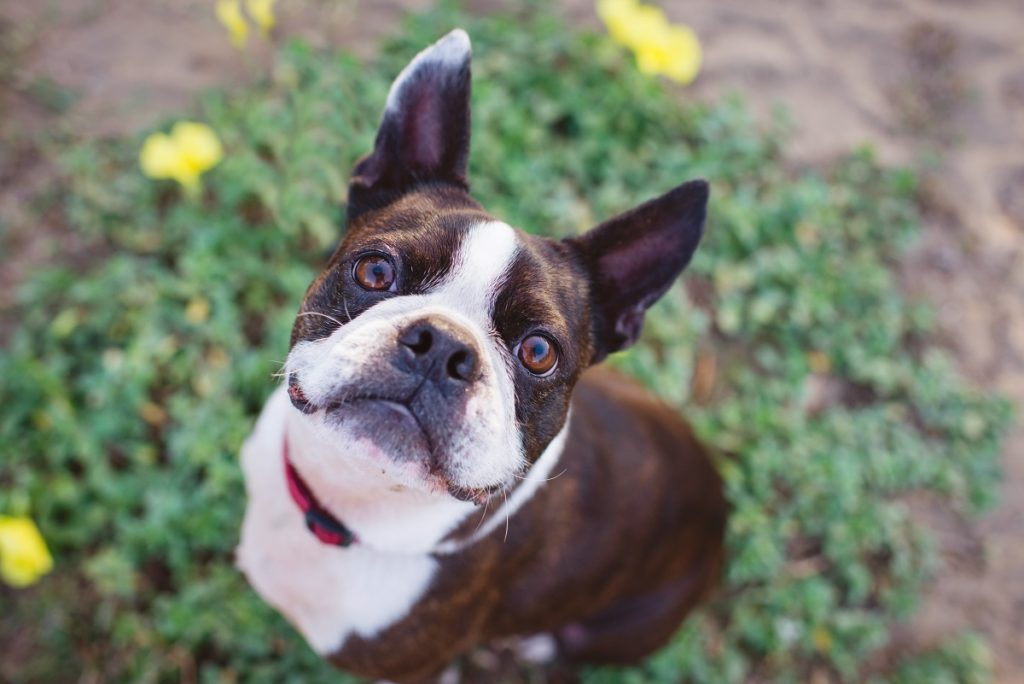The Boston Terrier is a visually distinct dog with large, sweet eyes, a “smooshed” face, a small to virtually-nonexistent tail, and energy that rivals that of a toddler with unfettered access to candy. Classed as a companion dog, Boston Terriers don’t have a driving need to herd or hunt, but that doesn’t slow them down one bit, at least in puppyhood. Older pups may be content to find a comfy corner of the couch to snooze the day away, but their younger counterparts need a good deal of attention and interaction from their pet parents to feel fulfilled.
Boston Terriers come in several varieties of black and white patterning, with the most memorable being the “tuxedo” configuration of primarily black with a white chest blaze, face markings, and “socks” on each leg and foot. Other colors, such as a brindle coat, the red-brown “liver” color, and even white Boston Terriers exist, though potential Boston pet parents should be aware that the latter is prone to genetic issues of deafness in one or both ears.
This article will address many commonly-asked questions regarding this cheerful and energetic breed, including Boston Terrier behavior, health issues, training & grooming tips, and much more.
Q: Are Boston Terriers Aggressive?
A: In general, the breed isn’t known for having a genetic disposition towards aggression – in fact, quite the opposite. Bostons are notorious for wheedling their way to sit or lay beside their pet parents, or sneaking into a lap for cuddle time. That said, any dog that feels defensive or unsure of its territory has the potential to exhibit aggressive behavior, so it’s best to keep a close eye on him as he grows. Here are a few ways to reduce the chances of aggressive behavior:
- Spaying or neutering at the appropriate age, if a dog isn’t intended for breeding: This will reduce a dog’s natural urge to dominate other dogs or even his parents, as hormones can be a powerful behavioral motivation to misbehave. In addition, this can help mitigate potential health problems later in life, as well as “jailbreak” urges to wander the neighborhood in search of a mate.
- Interacting with him during feeding, or feeding him by hand until he’s not food aggressive: If he growls or crouches closer to his food when a human or other animal approaches, he’s showing signs of food aggression. Normalizing petting and
 proximity while he’s eating will reassure him he can eat at his own pace and that his food supply is safe.
proximity while he’s eating will reassure him he can eat at his own pace and that his food supply is safe. - Consistently using the same discipline word or phrase – not his name: Work with friends and family to use the same discipline phrase or phrases – “no” or “down”, for example. During training, remove the ability for him to jump up or mount legs, and don’t sweet-talk him to behave – this will feel more like a negotiation than a command. Instead, deliver the phrase, break eye contact, and abruptly turn so that he does not have access to the front of the body or legs. Using “the phrase” instead of his name when scolding is important; it will ensure he doesn’t get mixed messages when he’s called by his name in a friendlier setting.
Q: Do Boston Terriers Have Health Problems?
A: As all breeds do, Boston Terriers have a predisposition to certain health conditions. Below, several distinctive physical characteristic traits to keep in mind when caring for a Boston Terrier:
- Face Shape & Health Issues: Boston Terriers, like pugs and bulldogs, are part of the brachycephalic family of dog breeds: those with “smooshed” faces that are prone to panting, loud breathing, and snoring. Because the shape of the skull and muzzle are shorter and somewhat folded in on themselves, Bostons should never wear “choke” style collars that tighten around the neck, even for training purposes. Instead, harnesses that are broad and keep the chest exposed allow pet parents to hold and guide their pup without obstructing his airway.
Dogs in this family of muzzle shapes can also pose additional risks during veterinary surgeries, as the anesthesia required can further obstruct an already poorly-shaped airway. If a “brachy” dog needs surgery, the risks must be carefully discussed with a vet beforehand.
- Face Shape & Feeding Time: The flattened Boston terrier face shape can also make feeding time a bit challenging. Traditional deep food bowls are designed for dogs with longer, slender muzzles and can be uncomfortable for the short, wide muzzle of Bostons. Pet parents of Boston Terriers recommend slow feeder style bowls, as these not only reduce the chance of “bolt and bloat” from eating too fast. These maze-like feeding dishes also provide him with ledges and edges to scoop food from, rather than needing to root around in a larger pile of food, which can cause breathing trouble. For water, large-bore water bottles are both easy to refill and easy for him to drink from, particularly when mounted on a crate or cage door.
- The “Back Half”: On the other end of the dog, Boston Terriers also have a tendency towards stubby and corkscrew tails. These nub-like tails are not the result of cutting or “docking” procedures as they are in breeds like Rottweilers, Bostons are born with them. Because these tails tend to grow (much like their muzzles) “smooshed in” to the body, there’s a potential for skin infections and serious complications.
Consequently, Boston Terriers need to have their tail and adjacent hindquarter areas cleaned frequently (particularly after eliminating), as feces and bacteria can quickly form sores or infections in the skin pockets caused by the tail shape. This complication is serious enough that Boston terrier breeders will perform special X-ray tests to demonstrate to purebred buyers that the mother and father of a pup are free of the undesirable trait.
Q: Are Boston Terriers Easy To Housebreak?
A: Boston terriers are small-to-medium dogs, and come with a stomach, digestive system, and bladder to match. That means they need more frequent “potty-breaks” than their larger canine counterparts, and aren’t a good choice for a pet if they’ll be left alone a great deal. In general, pet parents should avoid leaving a Boston alone for more than 4 hours at a time, as they’ll not only need to go outside and do their business, they’ll also potentially experience destructive separation anxiety.
 If the home has a yard: Avoid the temptation to simply turn him loose in the yard to pick a place to do his business. Part of training and owning a Boston Terrier is teaching him where to go, and that means putting him on a leash and leading him to a specific “potty” area – rain or shine. Reward him with excited praise, petting, and treats after he pees or poops, not before. He will associate the act of eliminating with that praise and treat, and from there he will respond to commands to “go potty” by returning to that specific area.
If the home has a yard: Avoid the temptation to simply turn him loose in the yard to pick a place to do his business. Part of training and owning a Boston Terrier is teaching him where to go, and that means putting him on a leash and leading him to a specific “potty” area – rain or shine. Reward him with excited praise, petting, and treats after he pees or poops, not before. He will associate the act of eliminating with that praise and treat, and from there he will respond to commands to “go potty” by returning to that specific area.
If the home does not have a yard: The small size of Boston Terriers makes them a favorite canine companion of townhome, condo, and apartment-dwellers. This poses a unique problem for pet parents that may struggle with time or mobility issues versus flights of stairs. Doggy pee pads are a potential solution for housebreaking a Boston that isn’t able to quickly go outside. Below, a few more helpful tips for housebreaking a Boston Terrier:
- Buy the largest pee pads available that are in-budget; this not only makes them easier to gather and clean up, it prevents near misses and the resulting messes.
- Don’t neglect potty-training rituals: just because he’s going inside doesn’t mean he can skip out on boundaries and expectations. Lead him to the pads and give the verbal command to eliminate, and be patient until he does.
- Be fastidious and quick about cleaning up and replacing soiled pads: if he doesn’t feel comfortable going in a “dirty” area, he’ll go elsewhere – like the carpet.
- Be prepared to stay resolute while training him, some Boston terriers can be stubborn, and may take weeks or even months to start housebreaking without resistance and accidents.
- If he does miss his pads, clean the area thoroughly to remove his urine scent. Otherwise, he may take it as a sign that it’s okay to eliminate there and repeat the behavior.
If he seems to “forget” housebreaking: Any sudden change in behavior is a red flag for a concerned dog parent, but a sudden shift in housebroken behavior is a big one. In older Bostons, this behavior may point to a health issue, such as a urinary tract infection, that affects his ability to hold his bladder. If he is defecating in the house and it doesn’t look right, he may have a parasitic infection – consult a vet to have a fecal test done to make sure he’s healthy enough to hold his bowels and nothing’s affecting his intestines.
If the problem is a consistent one, crating him or confining him in an area that’s easy to clean may help mitigate the symptoms while a diagnosis – behavioral or health – is made. The tiled floors of bathrooms and laundry rooms, combined with generously-sized puppy pads, help make clean-up fast and easy.
Q: Are Boston Terriers Destructive?
A: Because Boston Terriers are a favorite breed amongst people living in apartments, they often get a bad reputation as destructive chewers. In reality, many Bostons chew up furniture, objects, clothing, and shoes because they are anxious or bored: apartment or condo-dwellers often leave their dogs at home uncrated most of the day while they’re at work. These two tendencies combined cast the Boston Terrier in a very unfair (and unflattering) light.
If a Boston Terrier is left alone during the day, it should be in a confined area that he’s unable to jump, tunnel, or chew his way out of. Dog owners can test how secure his confinement is by closing him up while they’re still in the home and seeing if he’s able to wriggle his way out. Using unproven/untested gates or barriers rather than an enclosed crate can lead to a mess once parents arrive back home.
Bostons should be given plenty of toys to keep them engaged and occupied while they’re left alone, including toys like treat-dispensing balls that encourage interaction. Calm-inducing dog supplements can help dial back the breed’s anxiety and hyperactivity, and tech-toys like treat-dispensing two-way cameras can help stave off loneliness that leads to destructive behaviors. In a nutshell, it’s a pet parent’s responsibility to stow and store anything valuable before heading out for the day, or confine their beloved pooch to a comfortable, safe, doggy-proof area where these items can’t be reached.
Q: Do Boston Terriers Need To Be Groomed?
A: While Boston Terriers do have a comparatively short coat length in the dog world, they still benefit from professional grooming on a regular basis. In addition to the hygienic needs of their aforementioned tail issues, they also need their anal glands expressed periodically to avoid infection or irritation. The anal glands are located around the anus to each side, and the scent they emit is a dog’s signature – they’re the reason that dogs greet each other by making a beeline for one another’s behinds. While this procedure can be safely done at home, for obvious reasons a large percentage of Boston Terrier parents prefer to farm this notoriously stinky job out to a pro.
In addition to this admittedly unpleasant task, groomers also keep his coat clean and free of allergens like pollen – an important benefit for the brachycephalic Boston – and reduce the chances of skin irritation under his short coat. Properly-trimmed nails will also ensure his gait is smooth and even, preventing soreness and hip issues as he moves from young adulthood into his golden years as a senior dog. Removing dead fur and skin flakes may also cut down on itching and scratching, particularly during the dry winter and summer seasons.
While at-home baths with dog-friendly shampoo are a great habit between grooming visits, a Boston should see his groomer every few months for a doggie spa day, both for his health and his handsome looks. A groomer can also recommend an at-home care regimen, and point out any concerning irritation or wounds that might need veterinary intervention.
Boston Terrier TLC
Boston Terriers are a well-loved breed for a good reason: their devotion to their owners, their small and manageable size, and their alert intelligence make them a cherished pet. As long as their human handler is committed to keeping an eye out for breed-specific health issues and staying patient during potty-training, the bond between pup and parent is an easy one to forge.
Sources Cited:
- “Boston Terrier.” Dogtime.com, (no publish date), https://dogtime.com/dog-breeds/boston-terrier#/slide/1. Accessed September 22, 2019.
- Welton, Michele; Dog Trainer, Behavioral Consultant, Author. “Boston Terriers: What’s Good About ‘Em, What’s Bad About ‘Em.” Your Purebred Puppy.com, July 21, 2019, https://www.yourpurebredpuppy.com/reviews/bostonterriers.html. Accessed September 22, 2019.
- Hitchcock, Kristin. “Boston Terrier Temperament: What Will Your Dog’s Personality Be Like?” The Happy Puppy Site.com, February 2, 2019, https://thehappypuppysite.com/boston-terrier-temperament/. Accessed September 22, 2019.
- “Boston Terrier Dog Breed Information and Personality Traits.” Hill’s Pet.com, (no publish date), https://www.hillspet.com/dog-care/dog-breeds/boston-terrier. Accessed September 22, 2019.
- Fernandez, Colleen. “Is Your Boston Terrier Potty Trained Enough?” Boston Terrier Secrets.com, (no publish date), http://www.bostonterriersecrets.com/boston-terrier-house-training/is-your-boston-terrier-potty-trained-enough. Accessed September 22, 2019.




